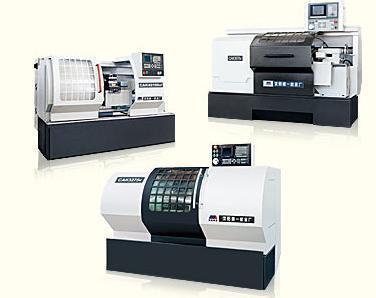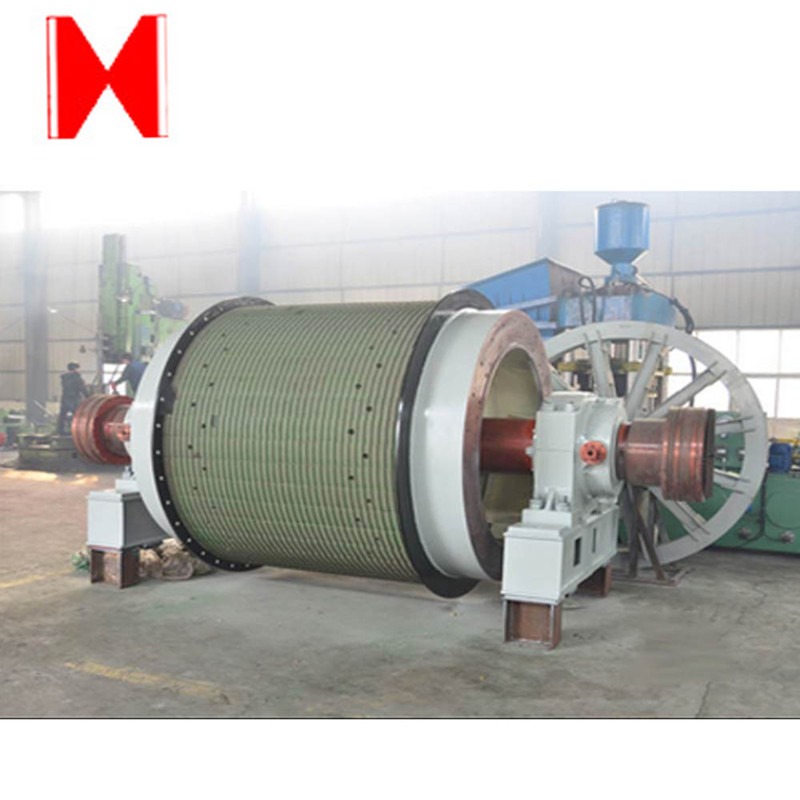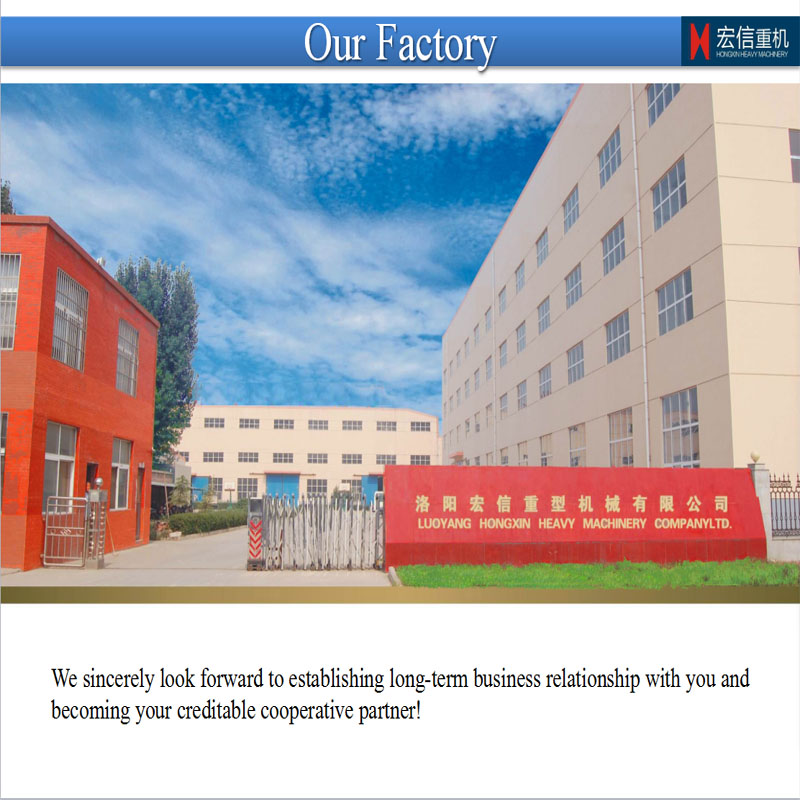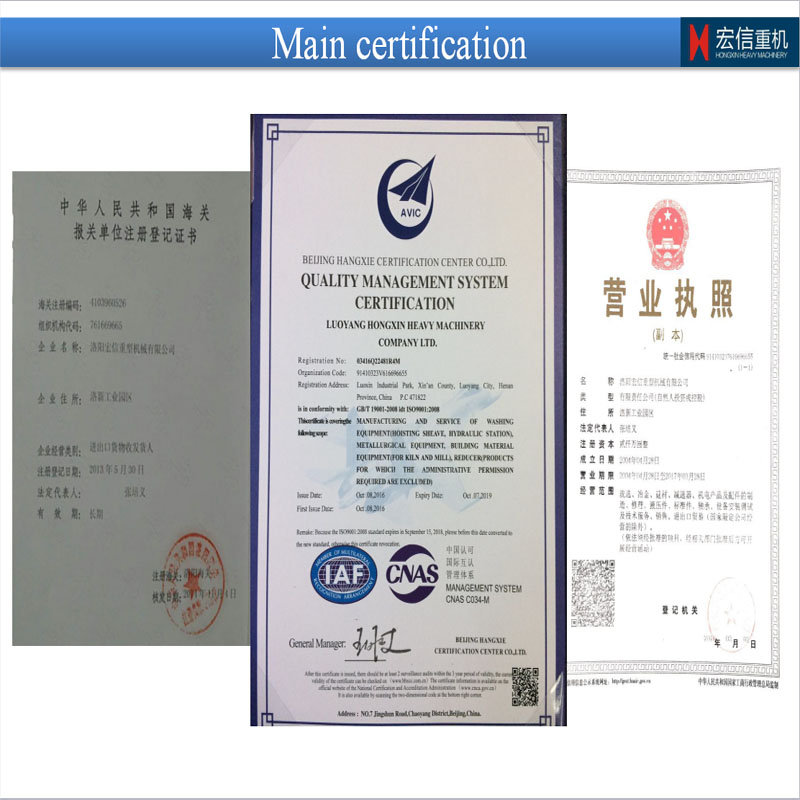Technical parameters
Name
specifications
1.8m
2m
2.2m
Product introduction
The products use for transporting materials and as important equipments in steel company. As the main equipments in feeding materials system, blast furnace hoist is the hoist machine that the material dragging trucks go along the skew bridge from the top of furnace to the materials pit.
Company Introduction
Luoyang Hong Xin Heavy Co., LTD. is located in Luoyang Xin'an Industrial Park, Luoyang Hongxin Heavy Machinery Co., Ltd is an enterprise featured with industrial designing, processing and manufacturing, which is qualified for import-export trade. Covering an area of 15,000 square meters and holding an annual production value of 80 million RMB, the company of 20 million RMB registered capital has total 100 staff members, among which there are 20 engineering technicians owning senior and medium professional titles and 40 intermediate and senior technicians capable of product designing and developing.
Hongxin is dedicated to produce reducers, hoists, crushers, Ball Grinding Mills and the equipments of screening, coal washing, metallurgy and cement, and replacement parts. Meanwhile, we provide the perform maintenance service for various series of equipments. There are 52 large-scale equipments applied into the manufacturing process, such as T200 CNC floor boring and milling machine, YK 73125 CNC molding gear grinding machine, YK322B CNC molding gear grinding machine, Y3200 gear hobbing machine, Y1600 CNC gear sharper, 4m vertical lathe, 6.3m CNC vertical lathe, T110 CNC boring machine, and 52 middle-sized productive and assistive equipments, which integrate strong manufacturing and processing capability with complete managing system of production and technology, quality management system and comprehensive testing measures.
Certificates
Contacts
Blast Furnace Hoist Blast Furnace Hoist,Electric Blast Furnace Hoist,Blast Furnace Skip Hoist,Horizontal Blast Furnace Hoist Luoyang Hongxin Heavy Machinery CO., TLD. , http://www.hxreducer.com At present, China's machine tool industry has entered a critical period of development. It must scientifically combine the needs of industrial development and organize and rhythmically adjust the industrial structure. This process is based on the complexities of seeking truth from facts, stressing actual results, and scientific attitudes. System Engineering. From the relevant departments of the government to the enterprises, it should be carried out in an orderly and steady manner. Leaders should set targets and conduct regular inspections. They should summarize their experiences in stages and effectively improve the problems encountered in the transition. The practice of going through the courts will delay the fight.
At present, China's machine tool industry has entered a critical period of development. It must scientifically combine the needs of industrial development and organize and rhythmically adjust the industrial structure. This process is based on the complexities of seeking truth from facts, stressing actual results, and scientific attitudes. System Engineering. From the relevant departments of the government to the enterprises, it should be carried out in an orderly and steady manner. Leaders should set targets and conduct regular inspections. They should summarize their experiences in stages and effectively improve the problems encountered in the transition. The practice of going through the courts will delay the fight.
As a modern and complex production tool, machine tools are one of the three most important tools in the development of human productivity. The “advancedness†of machine tools determines human productivity and labor productivity. As the most advanced science and technology in the world, the United States, in the 20th century, a hundred years, its machine tool technology has been in a leading position in the world, the same, its automotive industry, aerospace is also ranked first in the world. In 2008, the U.S. GDP was 13.98 trillion U.S. dollars, which was averaged by 310 million people and its per capita GDP was 45,000 U.S. dollars. China, with a population of about 1.33 billion, had a GDP of only 3.37 trillion U.S. dollars in 2008, which is a quarter of the U.S. year. The per capita GDP is even one-eighth that of the United States. What are the reasons? Lower productivity levels. The level of productivity depends fundamentally on the level of science and technology.
"In order to speed up the process of industrialization, we must start from a fundamental level and increase the productivity of science and technology. In addition to cultivating talent, we must pay attention to infrastructure construction. As an industrial machine tool, the revitalization of the machine tool industry is of utmost importance." Luo Baihui, Network Machine Tool Industry Research Center, said that taking a close look at the objective laws of the development of the world's machine tool industry, machine tools as a production tool belong to the category of fixed assets. The development of the machine tool industry is closely related to the economic status of various countries and the investment in fixed assets. During the economic boom period, there were many fixed asset investments, an increase in the number of machine tools required, and high technological advancement. As a result, scientific research was also strengthened, and the overall development of the machine tool industry was fast. An obvious example: In 2009, when the world suffered a severe economic crisis, world GDP fell by 2.2%, global trade volume dropped by 13%, and due to shortage of funds, investment in fixed assets contracted. In 2009, the total output value of the world's machine tool industry fell by 32%. The consumption of machine tools worldwide fell by 33%, exports fell by 38%, and imports fell by 41%. It was the first year in the 21st century that the world’s machine tool industry, output value, consumption, and import and export declined in full.
Looking at the growth of machine tool industry output value and consumption at the end of the 20th century, it also reflects the close relationship with the overall economic situation. During the four years from 1980 to 1983, global GDP declined, and the output value of the machine tool industry also decreased from US$26.5 billion in 1980 to US$19.15 billion in 1983. From 1984 to 1991, the world economic prosperity began to increase. The output value of the machine tool industry rose from 19.25 billion US dollars in 1984 to 42.45 billion US dollars.
In the late 1980s, the global economic prosperity, adequate capital, investment in fixed assets continued to increase, and the amount of research funding for machine tools increased. The global machine tool industry has been thriving. At that time, CNC machine tool technology also developed rapidly. Not only did it invest heavily in research and development of FMS (flexible manufacturing systems), CIMS (computer integrated manufacturing system) research also gradually began to develop, forming an upsurge of new technology, development and innovation in the world of machine tools. At that time, the “fever†status of this machine tool industry was still vivid.
However, since 1992, the trend of the world economy has changed. The total output value and consumption of the machine tool industry have started to decline with the drop of global GDP. At the same time, for FMS and CIMS products with advanced technological level, due to high R&D investment, Many key technical aspects have not yet been resolved, which leads to the low tide of development. In 1992, the world's machine tool output decreased from 42.45 billion U.S. dollars in 1991 to 34.12 billion U.S. dollars, a decrease of 19.6%. Since 1993, the world economy has rebounded again, and the output value and consumption of machine tools have also gradually increased. In 1996, the world's machine tool output increased to 38.03 billion U.S. dollars. By 2004, it had reached 45.63 billion U.S. dollars. Undoubtedly, the global economic ups and downs have a certain influence on the machine tool industry. Moreover, a global financial crisis will have a more profound impact on the machine tool industry.
This point is supported by the increase in machine tool output, consumption, and import and export volume in 28 countries and regions in the world in 2009.
In 28 countries and regions within the statistical scope, in 2009, the output value of machine tools in addition to China's growth of 7.4%, Austria's growth of 2%, the remaining 26 countries showed varying degrees of decline. China is due to the country's industrial revitalization plan and increased investment to drive the growth of the machine tool industry. Austria is a transit country for global machine tool trade. In the world's major machine tool manufacturing countries, the output value of the German machine tool industry fell by 33%, Japan by 54%, the United States by 41%, Switzerland by 47%, and so on.
At the same time, global machine tool spending decreased by 33% year-on-year. Since China and Brazil have adopted certain measures to stimulate economic growth, the growth rate of their consumption has been zero, and other countries (regions) have shown a declining trend. In 2009, the consumption of German machine tools fell by 44%, the United States by 51%, Japan by 57%, and Italy by 48%.
In addition, global machine tool exports have dropped by 38% overall, and imports have dropped by 41% overall. In this global financial crisis, market demand began to drastically reduce, and machine tool manufacturers were short of funds. The production and R&D of machine tools were inevitably affected to a certain extent.
After experiencing the world financial crisis, in 2009 the world's machine tool output value was 55.19 billion US dollars, and returned to the level of 53.83 billion US dollars in 2005. In the next five years, the future development of the world machine tool industry will depend on the recovery process of the world economic crisis. Of course, the situation in different countries and regions will be different depending on the correctness of the countermeasures adopted by countries in the world regarding the economic crisis.
According to the prediction of the UN Organization on January 20, 2010, the world economy will recover moderately in 2010. In 2009, world GDP fell by 2.2%, and it is expected to increase by 2.4% in 2010. However, if governments stop prematurely stimulative spending, the economy may fall into recession again. On June 27, the fourth summit of the leaders of the Group of 20 nations (G20) was held in Toronto, Canada. The decision was to reduce deficits on one hand and global recovery on the other.
In Luo Baihui's view, the world economy will gradually recover within five years, and the world's machine tool industry will continue to rise. If it goes well, the world's machine tool output in 2015 may approach the level of USD 81.34 billion in 2008.







